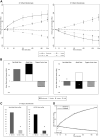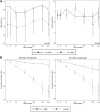Intradialytic acid-base changes and organic anion production during high versus low bicarbonate hemodialysis
- PMID: 32308019
- PMCID: PMC7311706
- DOI: 10.1152/ajprenal.00036.2020
Intradialytic acid-base changes and organic anion production during high versus low bicarbonate hemodialysis
Abstract
The use of high dialysate bicarbonate for hemodialysis in end-stage renal disease is associated with increased mortality, but potential physiological mediators are poorly understood. Alkalinization due to high dialysate bicarbonate may stimulate organic acid generation, which could lead to poor outcomes. Using measurements of β-hydroxybutyrate (BHB) and lactate, we quantified organic anion (OA) balance in two single-arm studies comparing high and low bicarbonate prescriptions. In study 1 (n = 10), patients became alkalemic using 37 meq/L dialysate bicarbonate; in contrast, with the use of 27 meq/L dialysate, net bicarbonate loss occurred and blood bicarbonate decreased. Total OA losses were not higher with 37 meq/L dialysate bicarbonate (50.9 vs. 49.1 meq using 27 meq/L, P = 0.66); serum BHB increased in both treatments similarly (P = 0.27); and blood lactate was only slightly higher with the use of 37 meq/L dialysate (P = 0.048), differing by 0.2 meq/L at the end of hemodialysis. In study 2 (n = 7), patients achieved steady state on two bicarbonate prescriptions: they were significantly more acidemic when dialyzed against a 30 meq/L bicarbonate dialysate compared with 35 meq/L and, as in study 1, became alkalemic when dialyzed against the higher bicarbonate dialysate. OA losses were similar to those in study 1 and again did not differ between treatments (38.9 vs. 43.5 meq, P = 0.42). Finally, free fatty acid levels increased throughout hemodialysis and correlated with the change in serum BHB (r = 0.81, P < 0.001), implicating upregulation of lipolysis as the mechanism for increased ketone production. In conclusion, lowering dialysate bicarbonate does not meaningfully reduce organic acid generation during hemodialysis or modify organic anion losses into dialysate.
Keywords: bicarbonate; hemodialysis; ketones; lipolysis; organic anion.
Conflict of interest statement
M. K. Abramowitz and T. H. Hostetter have consulted for Tricida, Inc. None of the other authors has any conflicts of interest, financial or otherwise, to disclose.
Figures








Comment in
-
Acid-base events during hemodialysis.Am J Physiol Renal Physiol. 2021 Jan 1;320(1):F130-F131. doi: 10.1152/ajprenal.00516.2020. Am J Physiol Renal Physiol. 2021. PMID: 33439106 No abstract available.
-
Reply to Gennari and Sargent: Acid-base events during hemodialysis.Am J Physiol Renal Physiol. 2021 Jan 1;320(1):F132. doi: 10.1152/ajprenal.00566.2020. Am J Physiol Renal Physiol. 2021. PMID: 33439107 No abstract available.
References
-
- Alfakir M, Moammar MQ, Ali MI, Alhatem E, Curran RD, Saoud RM, Chandran C, Khan MA, Debari VA. Pulmonary gas exchange during hemodialysis: a comparison of subjects with and without COPD on bicarbonate hemodialysis. Ann Clin Lab Sci 41: 315–320, 2011. - PubMed
-
- Buchanan C, Mohammed A, Cox E, Köhler K, Canaud B, Taal MW, Selby NM, Francis S, McIntyre CW. Intradialytic cardiac magnetic resonance imaging to assess cardiovascular responses in a short-term trial of hemodiafiltration and hemodialysis. J Am Soc Nephrol 28: 1269–1277, 2017. doi:10.1681/ASN.2016060686. - DOI - PMC - PubMed
Publication types
MeSH terms
Substances
Grants and funding
LinkOut - more resources
Full Text Sources
Medical

